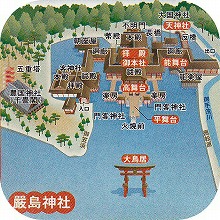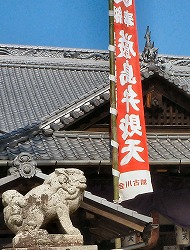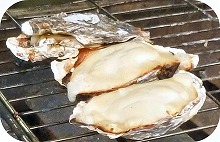Saturday, May 19th, the 3rd and last day.
We had enough time to see the sight of Aki-no-Miyajima in the morning.
Aki-no-Miyajima
Situated in Miyajima Town, Hatsukaichi City, it is a commonly known name.
But it is strictly called "Itsukushima", and known as one of
the three sights together with Matsushima and Amano-hashidate.
In the ancient times Itsukushima was the object of nature worship itself,
and since the end of Heian period (794-1192) it often appeared on the stage
of history because of the strength of the shrine's influence and its importance
as the base of ocean transportation.
This site has prospered as one of the most scenic spots in Japan since
Edo period (1603-1868). Presently over 300 million worshippers and sightseers
are said visiting here in a year.
We stayed here a whole day from the previous evening to a couple of hours
after lunch. There were a lot of people all over, not to mention a rural
place.
Itsukushima Shrine
 Itsukushima Shrine is in the center of Itsukushima as a matter of fact. Itsukushima Shrine is in the center of Itsukushima as a matter of fact.
The large torii floating on the sea and the halls of the shrine were built
in the ancient days (in 593).
The shrine prospered a lot under substantial patronage of Taira-no-Kiyomori
late Heian period (1118-1181).
Presently all halls, National Treasures and Important Cultural Assets,
are connected each other by the cloisters with the main hall as a center.
According to Wikipedia,
| Itsukushima Shrine is a Shinto shrine on the island of Itsukushima (popularly
known as Miyajima), best known for its "floating" torii gate.
It is in the city of Hatsukaichi in Hiroshima Prefecture. The shrine complex
is listed as a UNESCO World Heritage Site, and the Japanese government
has designated several buildings and possessions as National Treasures. |
For more information, please click here.
We already knew that the shrine had a damage by the raging rainstorm on
April 3rd this year, so that the torii could not be seen as a true red
one.
We noticed the reality on a sightseeing boat after dinner on the arrival
day. The next day in the afternoon, the repairing torii was before us in
the daylight. The repair would be completed by late June.
Now, Itsukushima Shrine. We toured in and around it in the whole morning.
I looked around the sights and sighed, murmuring at heart, with admiration
and fantasy going through my mind.
"It is not venerable just because it is a World Heritage Site. The
UNESCO people themselves must have asked it to be a World Heritage Site
in the result that the divine figures and gorgeous atmosphere beyond their
expectations directly came out to them."
I did not see NHK TV's golden drama "Taira no Kiyomori". Much
more than that, I stopped reading "New Heike Story" written by
Eiji Yoshikawa on the way and haven't started again yet. I'd like to read
it once again from the start when I come home.
However, as I am soon going to travel to China, I have to study it beforehand
too. In addition, I do not forget I stopped reading "The story of
Romanians" written by Nanami Shiono on the way too. My idea is as
fickle as the autumn weather.
…………………………
Daiganji Temple

We dropped in on the way to the 5-Story Pagoda without any reason. It is
said to be known as Kikyozan Hokoin, and was in charge of the repair and
construction of Itsukushima Shrine until the Meiji Restoration (1868).
 When the Ordinance Distinguishing Shinto and Buddhism was enforced in Meiji
period, many statues of Buddha, including the image of Benzaiten, were
moved from Itsukushima Shrine and enshrined here in the main hall. Benzaiten
is a goddess of music, eloquence, also wealth and water. That explained
why the Benzaiten flag was flapping here. (picture right) When the Ordinance Distinguishing Shinto and Buddhism was enforced in Meiji
period, many statues of Buddha, including the image of Benzaiten, were
moved from Itsukushima Shrine and enshrined here in the main hall. Benzaiten
is a goddess of music, eloquence, also wealth and water. That explained
why the Benzaiten flag was flapping here. (picture right)
We just looked at the appearance and put our hands together in prayer outside.
Five-Story Pagoda
Arrived here in 10 minute-walk from Daiganji Temple. It was originally
constructed in 1407, 27.6 meters high, and as a whole was constructed in
Japanese style as evidenced by the ornamental caps of the railing posts
as well as in the placement of the rafters.
Senjo-kaku Hall (Toyokuni Shrine)
This hall was just in front of the Five-Story Pagoda. We entered it, taking off our shoes, and looked around inside relaxed.
According to the homepage of Miyajima Tourist Association,
|
This hall is dedicated to the warlord Toyotomi Hideyoshi. The reason for building this structure is clearly stated in a letter by Ankokuji Ekei, head monk of Ankokuji Temple. In 1587, Ekei asked Daiganji Temple to build a Buddhist library in which the chanting of Senbu-kyo sutras could be held every month. As there is no board ceiling or outer gate, it is believed that the construction of the building was not completed.
The building is called Senjokaku (Hall of One Thousand Tatami Mats), reflecting its standing as the largest structure on Miyajima Island. The shrine was a popular landmark in Miyajima where many people came to relax and cool themselves and to buy popular souvenirs such as tooth picks, and a variety of legends and traditions have been created here.
The fact that this structure, unique among the buildings belonging
to Itsukushima Shrine, is unpainted and that its exact date of founding
is recorded, makes it a valuable gauge of the passage of time. The traces
of weathering on its pillars and floor boards can be used to determine
the approximate age of any other wooden structure on Miyajima.
|
It was worthwhile in the result to walk a little further from Itsukushima
Shrine. It was a dignified building, not gorgeous but quiet.
We were fascinated in the hall for a while, making ourselves at ease.
-----------------------
 What is gourmet food in Miyajima? What is gourmet food in Miyajima?
I would say "Surely raw oysters!", but unfortunately it was out
of season.
I ate two grilled oysters while standing. "Delicious!"
I chose a grilled-oyster platter for lunch too.
Emiko bought a couple of boxes of "momiji-manju" at a souvenir
shop in the restaurant.
A rickshaw with a newly-married couple on it was running in front of the
restaurant. Look at my nice snapshot.

After lunch we left Itsukushima and rode to Hiroshima.
|